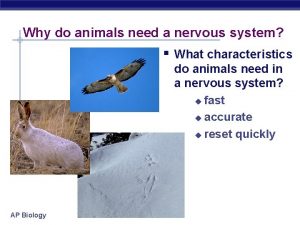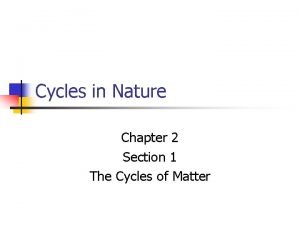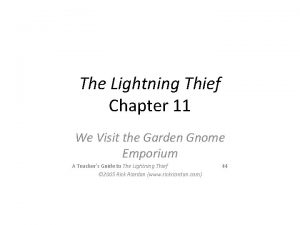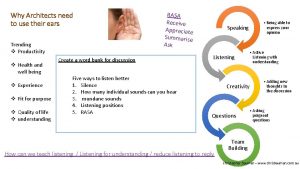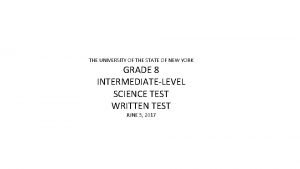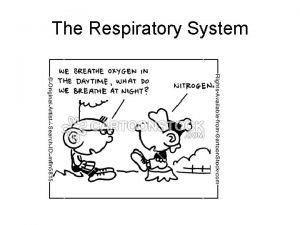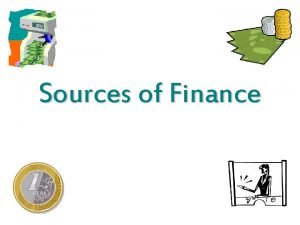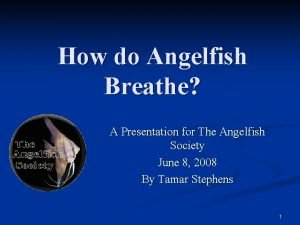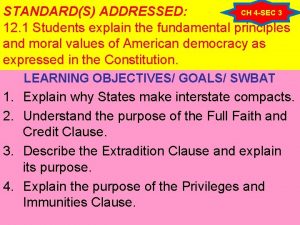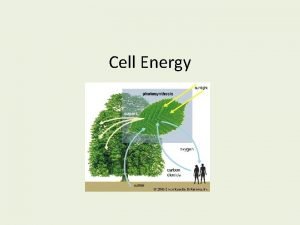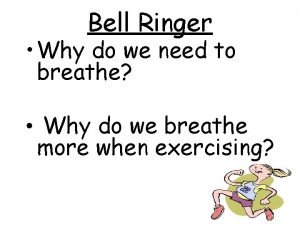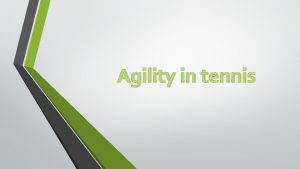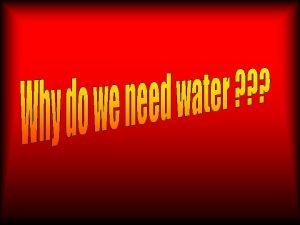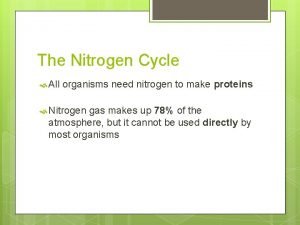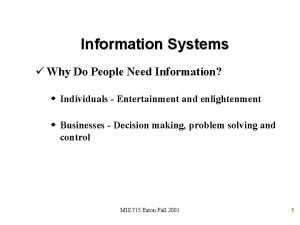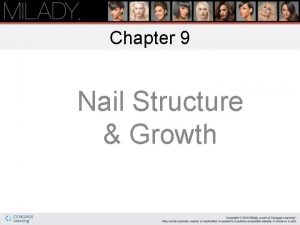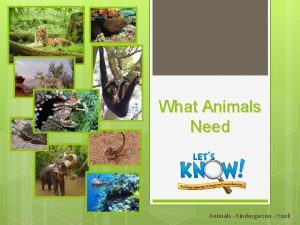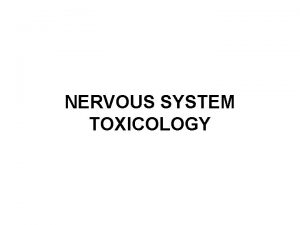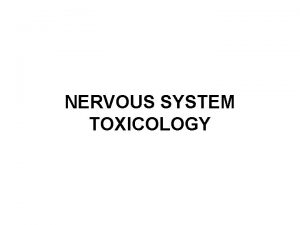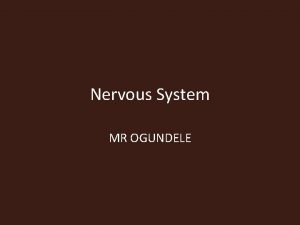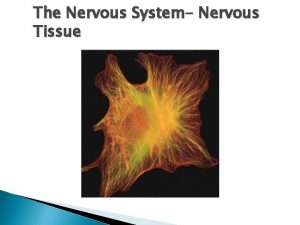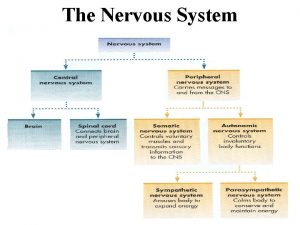Why do animals need a nervous system What


































- Slides: 34

Why do animals need a nervous system? § What characteristics do animals need in a nervous system? u fast u accurate u reset quickly AP Biology

Nervous system cells § Neuron signal u direction a nerve cell dendrites cell body § Structure fits function many entry points for signal u one path out u transmits signal u axon signal direction myelin sheath AP Biology dendrite cell body axon synaptic terminal synapse

Fun facts about neurons § Most specialized cell in § animals Longest cell u blue whale neuron § 10 -30 meters u giraffe axon § 5 meters u human neuron § 1 -2 meters Nervous system allows for 1 AP millisecond response time Biology

Transmission of a signal § Think dominoes! u start the signal § knock down line of dominoes by tipping 1 st one trigger the signal u propagate the signal § do dominoes move down the line? no, just a wave through them! u re-set the system § before you can do it again, have to set up dominoes again reset the axon AP Biology

Transmission of a nerve signal § Neuron has similar system protein channels are set up u once first one is opened, the rest open in succession u § all or nothing response a “wave” action travels along neuron u have to re-set channels so neuron can react again u AP Biology

Cells: surrounded by charged ions § Cells live in a sea of charged ions u anions (negative) § more concentrated within the cell § Cl-, charged amino acids (aa-) u cations (positive) § more concentrated in the extracellular fluid § Na+ Na K+ AP Biology aa- K+ Na+ aa. Cl- Na+ Cl. K+ Na+ aa- Na+ K+ aa- K+ Na+ Cl. Cl- Na+ aa- Na+ Na+ Claa- Cl- – K+ + channel leaks K++

Cells have voltage! § Opposite charges on opposite sides of cell membrane u membrane is polarized § negative inside; positive outside § charge gradient § stored energy (like a battery) + + + + – – – – – – – + + + + AP Biology

Measuring cell voltage unstimulated neuron = resting potential of -70 m. V AP Biology

Cell Depolarization § In order to transmit a nerve signal, the § § membrane must be depolarized The charge across the membrane must be reversed How can this occur? – + + + + – – – – Na+ + – – – – + + + + AP Biology

§ Synapse Video § Reception u Ion-gated channels on the nerve membrane open in response to a chemical neurotransmitter § Transduction u The chemical signal is converted into an electrical signal § Response u The electrical signal is converted down the entire nerve AP Biology

Chemical synapse axon terminal § Stimulation of a nerve action potential u synaptic vesicles synapse u Ca++ receptor protein u neurotransmitter acetylcholine (ACh) § ion-gated channels open u muscle cell (fiber) u AP Biology Neurotransmitter released into a synapse release neurotransmitter crosses synapse diffusion neurotransmitter binds with protein receptor neurotransmitter degraded or reabsorbed Stimulus stops

Neurotransmitters § Acetylcholine u transmit signal to skeletal muscle § Epinephrine (adrenaline) & norepinephrine u fight-or-flight response § Dopamine u u widespread in brain affects sleep, mood, attention & learning lack of dopamine in brain associated with Parkinson’s disease excessive dopamine linked to schizophrenia § Serotonin u AP Biologyu widespread in brain affects sleep, mood, attention & learning

Neurotransmitters § Weak point of nervous system u any substance that affects neurotransmitters or mimics them affects nerve function § gases: nitrous oxide, carbon monoxide § mood altering drugs: w stimulants n amphetamines, caffeine, nicotine w depressants n AP Biology quaaludes, barbiturates § hallucinogenic drugs: LSD, peyote § SSRIs: Prozac, Zoloft, Paxil § poisons

Learning Check § How can legal/illegal, medicinal or recreational drugs make our bodies respond when they are not naturally occurring chemicals within us? AP Biology

Nerve impulse in the next neuron § Post-synaptic neuron u triggers nerve impulse in next nerve cell § chemical signal opens ion-gated channels Na+ + ACh § Na diffuses into cell binding site § K+ diffuses out of cell u K+ Na+ Action Potential Demo ion channel K+ K+ Na+ – + + + + – – – – Na+ AP Biology + – – – – + + + +

How does a nerve impulse travel? § Stimulus: nerve is stimulated u reaches threshold potential § open Na+ channels in cell membrane § Na+ ions diffuse into cell u The 1 st domino goes down! charges reverse at that point on neuron § positive inside; negative outside § cell becomes depolarized – + + + + – – – – Na+ AP Biology + – – – – + + + +

How does a nerve impulse travel? § Wave: nerve impulse travels down neuron u u u The rest of the dominoes fall! Gate + change in charge opens + – + next Na gates down the line § “voltage-gated” channels channel Na+ ions continue to diffuse into cell closed “wave” moves down neuron = action potential + channel open – – – + + + + – – – Na+ + – – – – + + + AP Biology wave

How does a nerve impulse travel? § Re-set: 2 nd wave travels down neuron u K+ channels open § K+ channels open up more slowly than Na+ channels u u Set dominoes back up quickly! K+ ions diffuse out of cell charges reverse back at that point § negative inside; positive outside K+ + – – + + + + + – – – – – Na+ – + + – – – – – + + + + + AP Biology wave

How does a nerve impulse travel? § Combined waves travel down neuron u u Ready for next time! wave of opening ion channels moves down neuron signal moves in one direction § flow of K+ out of cell stops activation of Na+ channels in wrong direction K+ + – – + + + + – – – – Na+ – – – + + – – – – + + + + AP Biology wave

How does a nerve impulse travel? § Action potential propagates wave = nerve impulse, or action potential u brain finger tips in milliseconds! u In the blink of an eye! K+ + + + – – – – Na+ – – – – + + + + AP Biology wave

Voltage-gated channels § Ion channels open & close in response to changes in charge across membrane u u Structure & function! Na+ channels open quickly in response to depolarization & close slowly K+ channels open slowly in response to depolarization & close slowly K+ + + + + – – – – – + + + – – – Na+ – – – – – + + + + + – – – + + + AP Biology wave

How does the nerve re-set itself? § After firing a neuron has to re-set itself u u u A lot of work to do here! Na+ needs to move back out K+ needs to move back in both are moving against concentration gradients § need a pump!! K+ + Na Na+ + K K Na+ Na+ K+ K+ Na+ +Na + Na Na + + + + + – – +– – – – + + – Na+ Na K+ K+ + Na K K+ + + Na K K Na+ Na+ K+ – – – – – + + + + + – – + AP Biology wave Na+ +

How does the nerve re-set itself? § Sodium-Potassium pump u active transport protein in membrane § requires ATP 3 Na+ pumped out u 2 K+ pumped in u re-sets charge across membrane u AP Biology That’s a lot of ATP ! Feed me some sugar quick! ATP

Neuron is ready to fire again Na+ Na+ K+ aa- aa. Na+ Na+ K+ Na+ aa- K+ Na+ Na+ K+ aa. Na+ Na+ Na+ K+ aa- K+ K+ Na+ Na+ resting potential + + + + – – – – – – – – AP Biology + + + +

Video § Action potential 2 AP Biology

Action potential graph 1. Resting potential 2. Stimulus reaches Membrane potential threshold potential 3. Depolarization Na+ channels open; K+ channels closed 4. Na+ channels close; K+ channels open 5. Repolarization reset charge gradient 6. Undershoot + channels close slowly K AP Biology 40 m. V 4 30 m. V 20 m. V 10 m. V Depolarization Na+ flows in 0 m. V – 10 m. V 3 – 20 m. V Repolarization K+ flows out 5 – 30 m. V – 40 m. V – 50 m. V Threshold – 60 m. V 2 – 70 m. V – 80 m. V 1 Resting potential Hyperpolarization (undershoot) 6 Resting

Learning Check - Dominoes § What part of the nerve cell do the § dominoes represent? What is happening in the cell when the dominoes are reset? AP Biology

Myelin sheath § Axon coated with Schwann cells signal direction insulates axon u speeds signal u § signal hops from node to node § saltatory conduction u 150 m/sec vs. 5 m/sec (330 mph vs. 11 mph) myelin sheath AP Biology

action potential saltatory conduction Na+ myelin axon + + + – – Na+ Multiple Sclerosis § immune system (T cells) attack myelin sheath § loss of signal AP Biology

What happens at the end of the axon? Impulse has to jump the synapse! u u junction between neurons has to jump quickly from one cell to next How does the wave jump the gap? Synapse AP Biology

Chemical synapse axon terminal § Events at synapse action potential u synaptic vesicles synapse u u Ca++ u receptor protein neurotransmitter acetylcholine (ACh) u muscle cell (fiber) AP Biology We switched… from an electrical signal to a chemical signal action potential depolarizes membrane opens Ca++ channels neurotransmitter vesicles fuse with membrane release neurotransmitter to synapse diffusion neurotransmitter binds with protein receptor § ion-gated channels open u neurotransmitter degraded or reabsorbed

Learning Check § You bump the foot of the person sitting § next to you. In general terms, what is happening in your body that allows your to perceive & respond to this stimulus? How is this response different from the response your body would have if you touched a hot stove? AP Biology

Reflex Arc § Which scenario represented a reflex § arc? What is different about a reflex arc message? AP Biology

Questions to ponder… § Why are axons so long? § Why have synapses at all? § How do “mind altering drugs” work? u caffeine, alcohol, nicotine, marijuana… § Do plants have a nervous system? u AP Biology Do they need one?
 Why do animals need a nervous system
Why do animals need a nervous system Identify each type of neuronal pool
Identify each type of neuronal pool Fundamentals of the nervous system and nervous tissue
Fundamentals of the nervous system and nervous tissue Neuron processes
Neuron processes Andreas carlsson bye bye bye
Andreas carlsson bye bye bye Nervous system and digestive system
Nervous system and digestive system Endocrine system vs nervous system
Endocrine system vs nervous system Mechanism of hormone action
Mechanism of hormone action Adh function
Adh function How do plants get nitrogen
How do plants get nitrogen How do animals get the nitrogen they need
How do animals get the nitrogen they need Https://a-z-animals.com/
Https://a-z-animals.com/ Consumer decomposer producer
Consumer decomposer producer Detritus food chain
Detritus food chain Carnivore
Carnivore Dont ask
Dont ask Percy jackson and the lightning thief chapter 11
Percy jackson and the lightning thief chapter 11 Why architects need to use their ears
Why architects need to use their ears Shylock meaning
Shylock meaning Three living organisms
Three living organisms Why do we need to breathe
Why do we need to breathe Why do businesses need finance
Why do businesses need finance Why we need computer
Why we need computer Lamillae
Lamillae Why do we need arrays?
Why do we need arrays? Priveleges and immunities clause
Priveleges and immunities clause Why do cells need energy
Why do cells need energy Aerobic vs anaerobic respiration
Aerobic vs anaerobic respiration Agility in tennis
Agility in tennis We need to water
We need to water Why do organisms need nitrogen?
Why do organisms need nitrogen? Why do people need information
Why do people need information Why do we need cracking
Why do we need cracking Why do managers need to familiarize the nail structure
Why do managers need to familiarize the nail structure Nature of business finance
Nature of business finance
